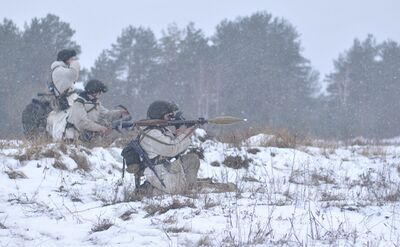Operation Sidewinder: Difference between revisions
(Created page with "{{Infobox military conflict | conflict = Operation Sidewinder | width = | partof = 2019 Invasion of Vyzhva | image = 400px | i...") |
No edit summary |
||
| Line 27: | Line 27: | ||
| units2 = Vyzhvan Armed Forces | | units2 = Vyzhvan Armed Forces | ||
| units3 = | | units3 = | ||
| strength1 = 500,000 troops </br> 4, | | strength1 = 500,000 troops </br> 4,000 tanks </br> 3,300 artillery pieces </br> 435 aircraft | ||
| strength2 = 300,000 troops </br> 2,200 tanks </br> 1,000 artillery pieces </br> 75 aircraft | | strength2 = 300,000 troops </br> 2,200 tanks </br> 1,000 artillery pieces </br> 75 aircraft | ||
| strength3 = | | strength3 = | ||
Revision as of 02:25, 4 October 2020
| Operation Sidewinder | |||||||
|---|---|---|---|---|---|---|---|
| Part of 2019 Invasion of Vyzhva | |||||||
 Kolodorian forces invading Vyzhva | |||||||
| |||||||
| Belligerents | |||||||
|
| Vyzhva | ||||||
| Commanders and leaders | |||||||
|
| Some guy | ||||||
| Units involved | |||||||
|
First Army Group Second Army Group | Vyzhvan Armed Forces | ||||||
| Strength | |||||||
|
500,000 troops 4,000 tanks 3,300 artillery pieces 435 aircraft |
300,000 troops 2,200 tanks 1,000 artillery pieces 75 aircraft | ||||||
| Casualties and losses | |||||||
|
1,948 killed 6,202 wounded |
~15,000 killed ~40,000 wounded 50,000 captured | ||||||
Operation Sidewinder was the code-name for Kolodoria's military operations during the 2019 Invasion of Vyzhva. It was the largest employment of the Kolodorian People's Defense Forces since the Vinyan War, surpassing Kolodorian forces during the Cherniyan War. More than 500,000 Kolodorian troops, 4,000 tanks, 3,300 artillery pieces, and over 200 aircraft took part in the operation, which constituted the largest continuous front of the invasion.
Kolodoria was among the first non-Ivernic states made aware of the intention to invade Vyzhva by Tír Glas. Kolodorian preparation for the invasion consisted of a massive deception campaign to avoid detection by Vyzhvan intelligience, including extensive mobilization of Kolodorian reserves in place of active forces. Kolodorian troops were organized into two main forces, First Army Group positioned along the eastern border, and Second Army Group along the northern border. Although Glasic leadership had intended to conduct an extensive air campaign from Glasic, Dayashinese, and Hallian air power, the KPDF convinced its counterparts to implement a concurrent ground offensive to overwhelm Vyzhvan forces in one fell swoop. While Ivernic, Dayashinese, and Hallian forces were assigned to invade the more urbanized southern portions of Vyzhva, Kolodorian forces were to invade on a broad front to draw away as many Vyzhvan reserves as possible and avoid a prolonged urban conflict in the south.
Vyzhvan forces on paper fielded some 300,000 troops and thousands of armored fighting vehicles and artillery pieces, but lack of forewarning led to uneven mobiliziation orders that left the Vyzhvan Armed Forces in poor position to repel the invasion. Kolodorian forces began their operations in the early morning on 14 Febuary 2019 with shelling along the entire border, following by a general invasion along the Ullan line and Phase Line Korin. Vyzhvan forces offered fierce but disorganized resistance, and by the end of Febuary had broken through Vyzhvan lines along the border and advanced on Prognoi and Kupka. Pitched urban battles occurred in both cities, which were captured by 19 March. Major offensive operations subsided shortly afterwards, with Kolodorian forces clearing out remaining resistance in the Vyzhvan interior. Sidewinder is generally considered to have concluded on 21 April, along with the rest of the conflict.